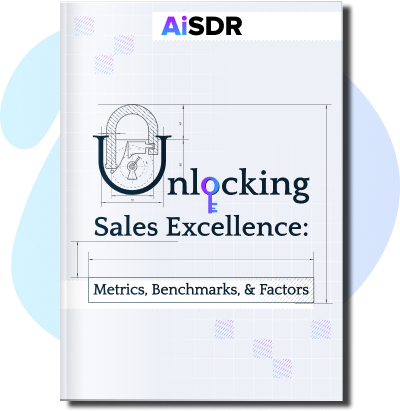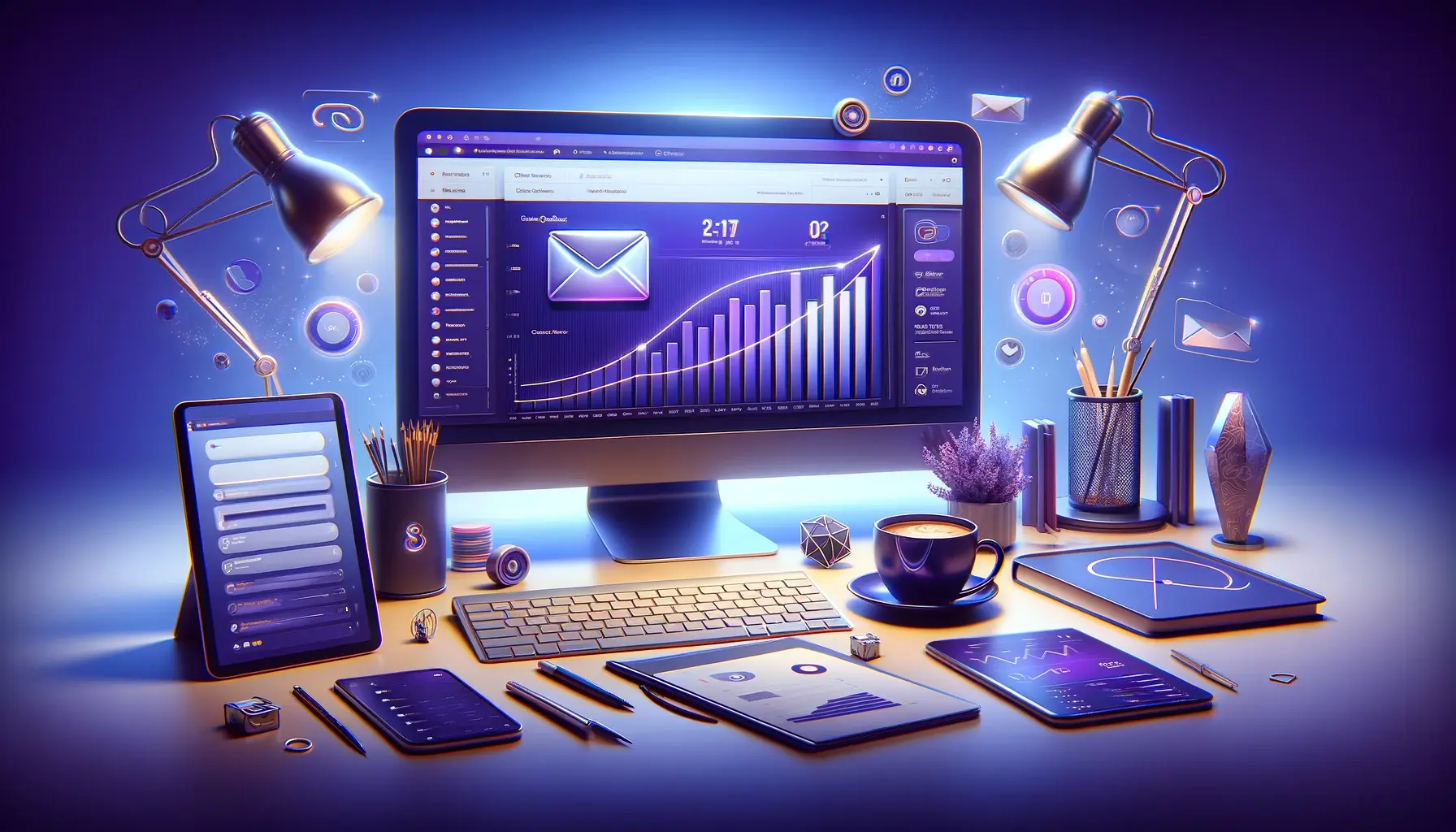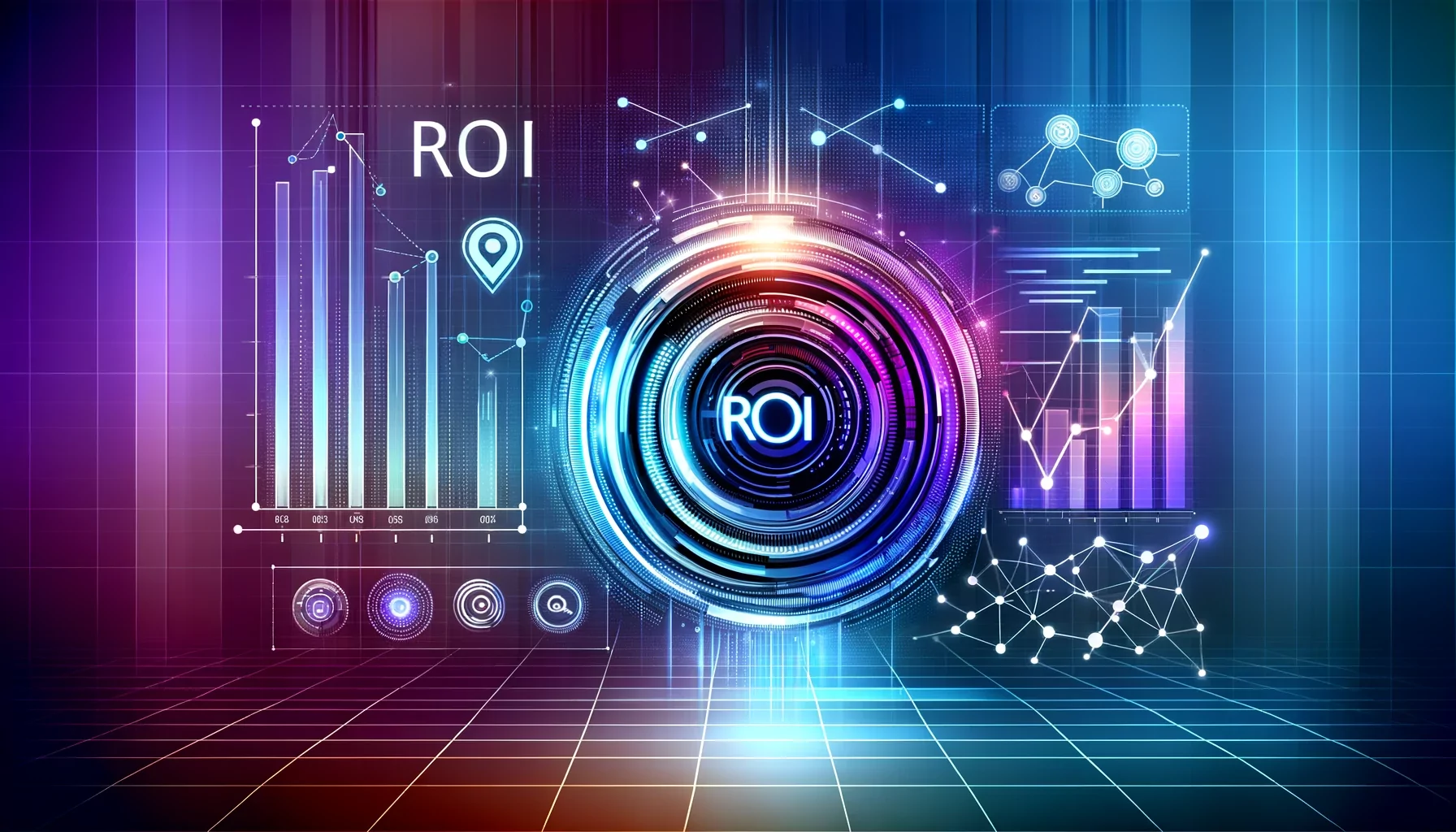8 Signs Your SDR Performance Is Lacking

Keep an eye out for these 8 red flags to prevent your sales outreach from stalling
At many companies, sales development representatives (SDRs) are the ones responsible for finding, reaching out, and nurturing potential customers until they’re ready to buy your product.
It sounds all well and good in theory, but it’s much harder in practice. In the real world, your company’s bottom line will suffer if your SDRs are struggling with outreach, qualification, or nurturing.
That’s why it’s important to watch for potential signs and red flags that your SDRs aren’t able to meet their sales targets.
Find out more about eight reasons why your SDR performance is stalling, as well as how virtual SDRs like AiSDR can help.
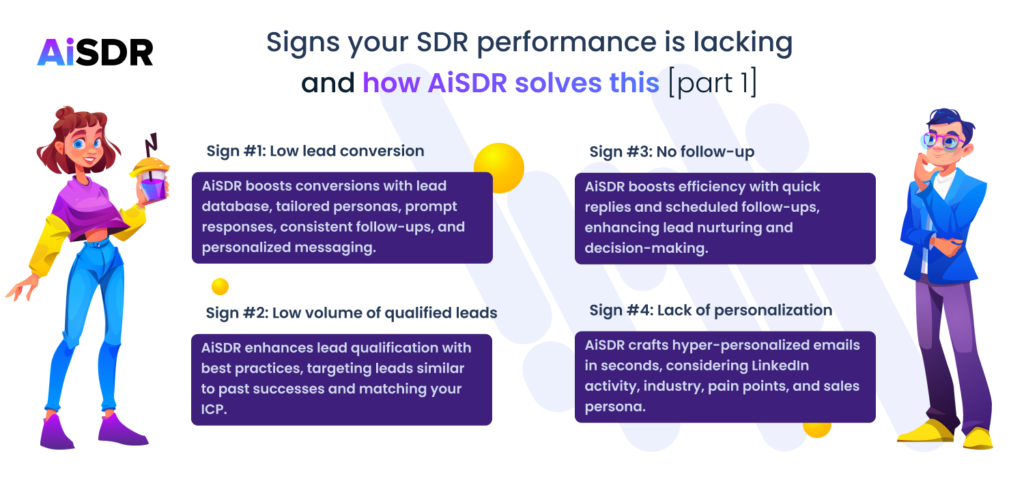
Sign #1: Low lead conversion
The first red flag is arguably the biggest – If your lead conversion rate is dropping, there’s a problem.
Perhaps your SDRs are failing to effectively showcase your product’s value and engage prospects. Or maybe they’re misclassifying leads and sending uninterested or unqualified prospects down the pipeline. In any case, the end result is your sales team wasting time and resources on leads who won’t convert, leading to missed revenue targets and discouragement.
How AiSDR solves this
As an end-to-end AI SDR platform, there are several ways for AiSDR to improve lead conversion rates. This includes:
- Lead Discovery – AiSDR’s built-in lead database
- Sales personas
- Ideal customer profiles
- Prompt responses
- Consistent follow-ups
- Personalized content and messaging
Each of these capabilities will help you improve poor SDR performance. For instance, imagine a lead from the retail industry wants to know how your product can improve inventory management. A new or inexperienced SDR might not know, but AiSDR will use your info to provide a clear and complete answer.
Sign #2: Low volume of qualified leads
You may have obtained a decent number of leads, but you might find that too many of them don’t match your ideal customer profile (ICP). This mismatch will likely result in no deal being struck, as well as your sales team losing time and energy.
Poor lead prospecting and qualification are the likely culprits. This could be due to your SDRs looking for potential customers in the wrong places, or they may not understand the product well enough to know which customers are the best match. For example, a sales rep at a medtech company may be reaching out to leads from small clinics even though the company’s products are designed for hospitals and medical centers.
How AiSDR solves this
AiSDR can help you easily avoid these pitfalls by relying on best practices in lead qualification. You can feed your sales data to AiSDR to have it pursue leads similar to those that have proven successful. Alternatively, you can take advantage of Lead Discovery to determine which prospects match your ICP.
Sign #3: No follow-up
Following up with every prospect may seem like a no-brainer, but when your SDR team is swamped, they will struggle to send timely follow-ups. This might cause leads to slip through the cracks or opt for your competitor instead. Consequently, your campaign’s ROI will drop while customer acquisition costs soar.
How AiSDR solves this
AiSDR has you covered. Not only will our sales AI bolster work efficiency by sending quick replies within 10 minutes, but it will send follow-ups on schedule, preventing leads from going cold. This improves your chances of successfully nurturing and nudging them to a positive decision. Moreover, AiSDR’s messages will consider all previous interactions with a specific lead.
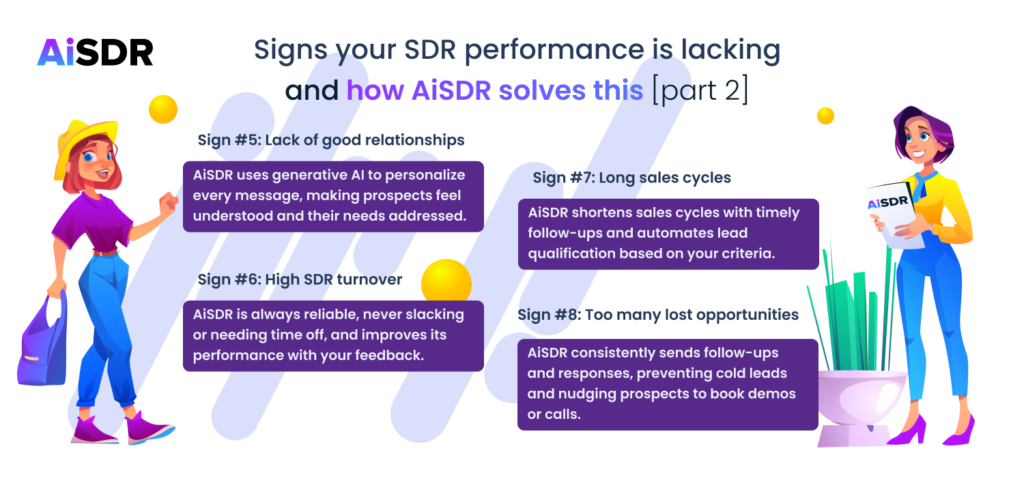
Sign #4: Lack of personalization
Nowadays, prospects expect incoming sales emails to be personalized. But if your sales reps are overloaded with other SDR tasks, chances are they may start sacrificing personalization in the interest of efficiency. On top of that, pre-made email templates and sequences aren’t the most flexible when it comes to personalization, nor do they prioritize delivering value to prospects.
How AiSDR solves this
AiSDR excels at creating and sending hyper-personalized emails. While a human SDR needs ~20-30 minutes to craft a personalized email, AiSDR generates 100% unique messages in mere seconds, significantly accelerating work velocity in the process. Each message takes into account a lead’s recent LinkedIn activity, as well as other factors like the industry, pain points, solutions, and underlying sales persona.
Sign #5: Lack of good relationships
Building a relationship is challenging even in the best of times. However, this is just one of the many responsibilities of SDRs.
When pressed for time, SDRs may prioritize quantity of leads over quality – in other words, they’ll adopt a “whatever sticks” mindset. While a shotgun approach is far from the worst outcome, it’s also far from optimal and efficient. Your customer lifetime value will start to sink while your customer acquisition costs skyrocket. And if you did manage to finalize a sale, poor relationships from the get-go will result in high churn.
How AiSDR solves this
AiSDR leverages generative AI for sales to ensure that all correspondence with a particular lead is personalized and relevant. As a result, every message is tailored so that prospects feel like your company can and will solve their pains if given the opportunity.
Sign #6: High SDR turnover
A high turnover rate is both a red flag and a result of poor SDR performance. Sales reps might leave because they’re mandated to succeed despite unrealistic targets, inadequate training, lack of career advancement opportunities, or poor management. Regardless, every time an SDR leaves, you have to recruit and train new SDRs, resulting in underperformance and limited capacity until they get up to speed (unless they also decide to leave).
How AiSDR solves this
Since it’s an AI, AiSDR will never:
- Have a bad day.
- Quit.
- Call in sick.
- Go on vacation.
- Slack off on Friday evenings.
Once you’ve set up AiSDR, it will continue to run and manage your outreach campaigns until the moment you stop the campaigns. And if you provide feedback to AiSDR, along with examples of previously successful emails, AiSDR will even improve its performance and quality of messaging.
Sign #7: Long sales cycles
Are your sales cycles longer than the average for your industry? If the answer’s yes, it’s a sign that your SDRs might be working inefficiently. This could be due to several reasons:
- Are your leads being qualified properly?
- How many decisions are being demanded of your leads?
- Is information being lost during the sales process?
- Have your SDRs provided sufficient information and examples?
Ultimately, the longer your sales cycle, the more likely it is that your leads may decide to abandon the process and opt for a quicker option. This is especially true for non-enterprise organizations like start-ups, solopreneurs, and small businesses.
How AiSDR solves this
AiSDR can help shorten sales cycles by sending timely follow-ups, providing essential decision-making information to leads, and checking how qualified your leads are. All you need to do is feed your qualification criteria into AiSDR and it will automate the qualification process for you.
Sign #8: Too many lost opportunities
Every lead who goes cold represents a lost opportunity. In today’s economic environment, too many lost opportunities could lead to massive layoffs and other strict cost-reduction measures.
It’s impossible to obtain a 100% win rate. But so long as your successes outweigh your losses, you can consider your company “default alive”.
Lost opportunities could occur for a plethora of reasons:
- Your SDR didn’t send a response in 10 minutes.
- Your SDR forgot to send a follow-up email.
- Your SDR had a bad day, which was reflected in the email.
No matter the reason, a lost opportunity is a lost opportunity, which means lost revenue.
How AiSDR solves this
As a conversational AI for sales, AiSDR never has a bad day, nor does it forget to send follow-ups and responses to potential clients. AiSDR will help prevent leads from going cold for easily avoidable reasons. It will also gently nudge lukewarm prospects into booking demos or sales calls, which opens up chances for you to boost your win rate.
Optimize your SDR performance with sales enablement AI
SDRs are your company’s first point of contact with potential customers. In an ideal world, they’ll approach the right targets, make them fall in love with your product, and move them on to the core sales team. But when they struggle with any of these responsibilities, your business will suffer – lost revenue, high customer acquisition costs, low sales team morale, etc.
You can boost your SDR performance by using AI-based sales automation tools. They allow you to delegate high-volume, repetitive tasks to AI so that you can get the most out of your SDR team.
Book a demo to explore how AiSDR can enable you to achieve your SDR targets.
FAQ
What is the average length of a sales cycle?
The length of a sales cycle varies, but it typically takes anywhere between one and six months. It depends on what you sell and who you sell it to. For example, selling software to a small business is usually faster than striking a big corporate deal. The key is to keep the cycle as short as possible but without rushing your customer.
How long does an SDR usually stay with a company?
SDRs often remain with a company for about 18 months. SDR is usually a stepping-stone role where young professionals learn the ropes and then move up or explore other opportunities.
How many follow-ups should an SDR send to a lead?
Usually, an SDR should try between three and five follow-ups with a lead. It’s all about striking a balance – being persistent but not too pushy. After all, you don’t want to come off as annoying. A follow-up should serve as a gentle nudge, a reminder that you’re there and ready to help.

